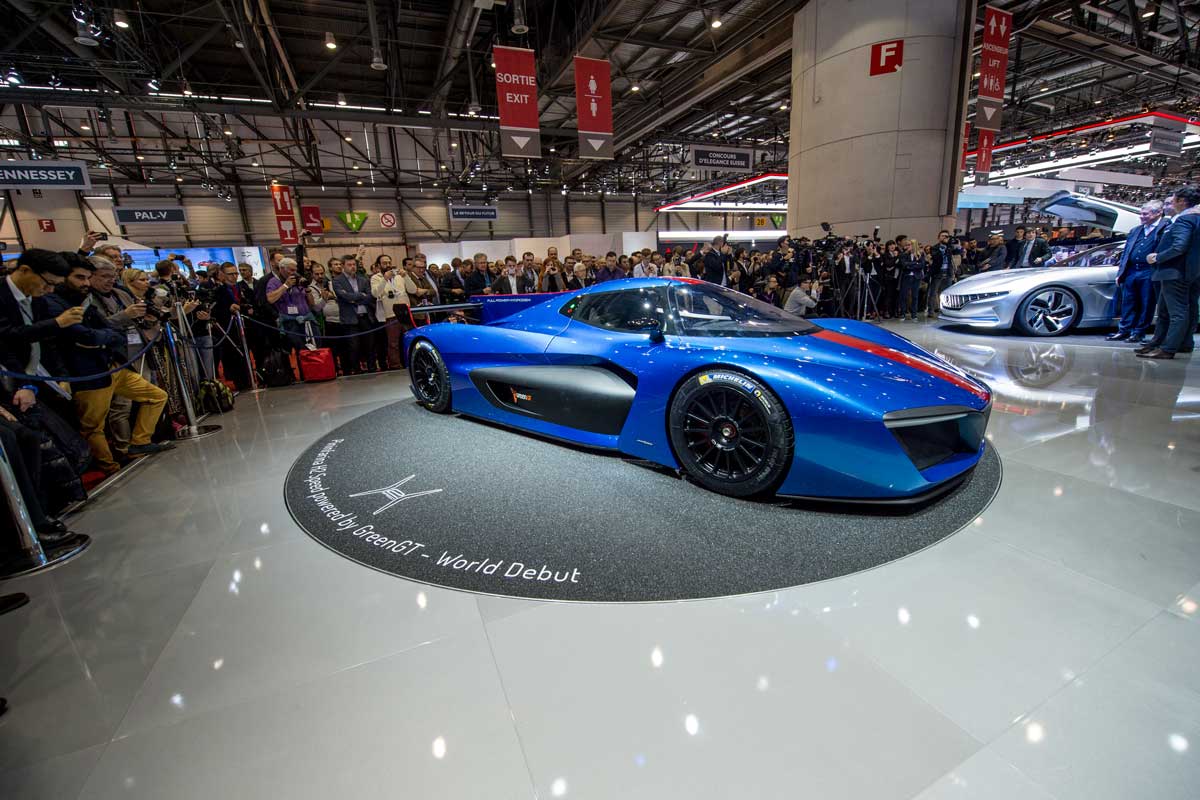ADESS at the core of the H2 Speed project!
On Tuesday 6th March GreenGT and Pininfarina revealed the rolling chassis of the H2 Speed at the Geneva International Motor Show. ADESS, a partner in the project, supplied the carbon cell around which this electric-hydrogen fuel cell powered supercar is constructed.
The H2 Speed concept presented two years ago by GreenGT has now become a reality that was revealed at the 2018 Geneva International Motor Show. The prototype electric-hydrogen fuel cell-powered supercar designed by Pininfarina was on display on the Italian company’s stand. It is the first of a series of 12 cars destined for private clients for track use.
ADESS was entrusted with the design and construction of the carbon chassis of this exceptional car. It was developed on the basis of an LMP cell adapted to the particular specification of the project. The team of engineers and composite specialists took up this challenge in which they invested all their skills and enthusiasm.
"Accompanying such an avant-garde project in the world of the motor car is a major technical challenge," explains engineer Stéphane Chosse, the ADESS general manager. "To design the chassis of a traditional high-performance vehicle whether it’s for racing or road use, we can call on tried and tested solutions that have proved themselves and were validated a long time ago in a known technical world. But the H2 Speed evolves in another dimension. Of course, it’s still a question of running the car as quickly and for as long as possible, but the constraints are completely new. An electric-hydrogen power unit does not present itself in the same way as, and does not behave like, an internal combustion engine. In fact, they have nothing in common with each other: not the dimensions, not the weight distribution, not the fluid circulation system, not the mechanical constraints. To get the best performance out of a car the installation of the power unit in the chassis must be flawless; and a perfect osmosis in the way they interact with each other must be achieved. The chassis is there, first of all, to give the power unit everything it needs to optimise what it, in turn, gives to the car by ensuring the lowest possible installation and the most efficient fuel feed and cooling systems. Then it must enable the power to be delivered in a constant manner and give the driver balance and precision in transition phases like braking, reacceleration, cornering, changes in grip etc. In all these domains we had to cope with new challenges imposed by the electric-hydrogen high-performance power unit. It’s because we were able to take them up that GreenGT and Pininfarina chose us. The fact that they recognised our fledgling company’s skills is a source of great satisfaction for our whole team."
ADESS is an engineering company founded in 2012 that specialises in the design, production and development of high-performance vehicles for motor car and motorbike racing.
GreenGT is an engineering laboratory founded in 2009 that specialises in high-performance electric-hydrogen fuel cell solutions for the motor car and the transport industry.
Pininfarina is the most famous Italian firm in the domain of motor car design and limited series production runs. It was founded in Turin in 1930 by Battista “Pinin” Farina and is the world benchmark in Italian automobile elegance.
The H2Speed is the first high-performance car powered by an electric-hydrogen fuel cell, which is at the core of its electric energy unit and produces the electricity that feeds its four electric engines. To run, the H2 Speed consumes only hydrogen and air and rejects nothing other than water vapour into the atmosphere. The first units of the series of 12 cars will be delivered to clients at the end of 2018. They are reserved for use by their owners at the most beautiful circuits in the world during dedicated weekends.
Technical specification:
Chassis:
LMP carbon chassis and steel structure
Suspension: wishbones and push rods
Carbon brakes
Engine:
GreenGT electric hydrogen energy powertrain (4-stack fuel cell with electrolyte polymer membrane) delivering 250 constant kW
4 electric racing engines
Maximum power: 480 kW at 13000 rpm (653 bhp)
2.4 kWh energy recovery system under braking transmitting 250 kW for 20 seconds
Transmission:
Direct drive to rear wheels (ratio: 1:6,3)
No gearbox, no clutch, no mechanical differential
GreenGT variable torque management system
Hydrogen storage:
Fuel tank capacity: 8,6 kg of hydrogen
Storage pressure: 700 bars
Energy recovery system under braking:
750 V battery nominal
Capacity: 2.4 kWh
Dimensions:
Length: 4730 mm
Height: 1113 mm
Width: 1956 mm
Wheelbase: 2968 mm
Front overhang: 987 mm
Rear overhang: 775 mm
Weight: 1430 kg in running order
Weight variation during refuelling: + 8.6 kg
Weight distribution: front 41%, rear 59%
Wheels:
Front 30/68-18 Michelin Pilot Sport GT (rim 12x18)
Rear 31/71-18 Michelin Pilot Sport GT (rim 13x18)
Performance:
Maximum speed: + 300 km/h
0 – 100 km/h: 3.4 seconds
400 m standing start: 11 seconds
Autonomy: equivalent to that of a racing car with the same performance
Refuelling time: 3 minutes
Emissions into the atmosphere:
Only water vapour
CONTACTS:
www.adess-ag.com
twitter : @ADESS_Official
facebook : facebook.com/WeAreADESS
www.greengt.com
twitter : @GreenGTOfficiel
facebook : @GreenGTOfficiel
youtube : GreenGT
instagram : @greengt_officiel
www.pininfarina.com
twitter.com/PininfarinaSpA
facebook.com/PininfarinaSpA
instagram.com/pininfarina_official
youtube.com/user/pininfarinaofficial


